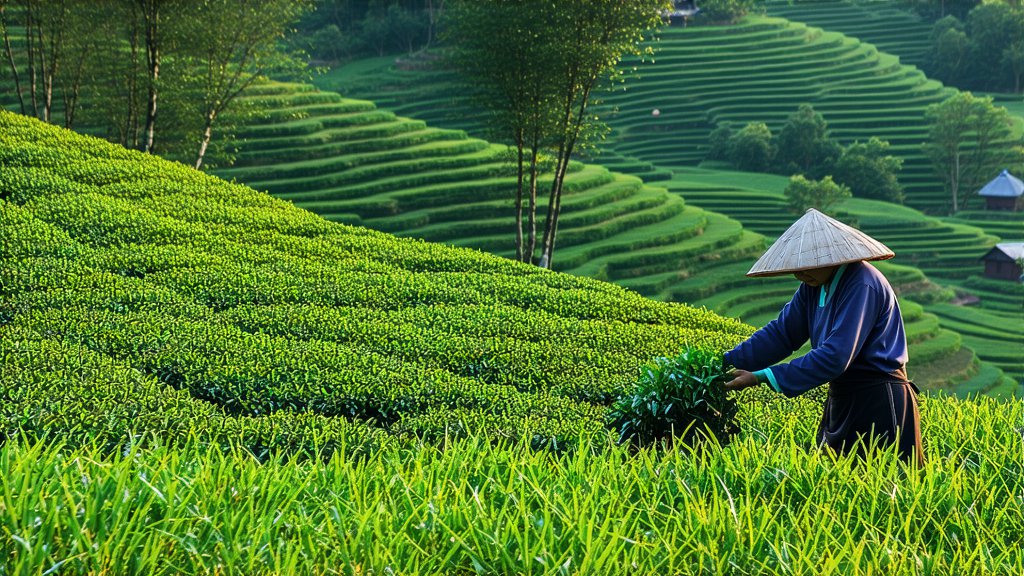
Nestled in the heart of China's Hunan province lies the picturesque Junshan region, where the art of tea cultivation has been perfected over centuries. Among its many treasures, Junshan Yinzhen stands as a shining example of China's revered yellow tea category. This exquisite beverage, known for its unique processing method that imbues it with a golden hue and distinct flavor profile, is not just a drink but an experience—one that encapsulates the essence of Chinese tea culture.
Historical Roots and Cultural Significance
The history of Junshan Yinzhen dates back to the Tang Dynasty (618-907 AD), making it a timeless testament to China's rich tea heritage. Legend has it that the tea was first discovered by a local farmer named Wen Zhengqing, who noticed the peculiar yellow coloration of certain tea leaves during their natural drying process under the sun. Intrigued by this phenomenon, he experimented with controlled fermentation, thus giving birth to what we now know as Junshan Yinzhen.
Throughout the ages, Junshan Yinzhen has been cherished by emperors and scholars alike, becoming synonymous with refinement and sophistication. Its name, "Yinzhen," translates to "silver needle," a poetic reference to the fine, downy hairs that cover the young tea buds, resembling silver threads amidst a sea of green.
Varieties and Classification
Junshan Yinzhen belongs to the broader category of Huangcha or yellow tea, which is relatively rare compared to more common varieties like green or black tea. Within this category, Junshan Yinzhen holds a special place due to its meticulous production process and unparalleled quality. There are several sub-varieties, each distinguished by subtle differences in taste, aroma, and appearance, often influenced by factors such as altitude, soil composition, and the specific microclimate of the tea gardens.
Crafting the Golden Elixir: The Art of Production
The magic of Junshan Yinzhen lies in its intricate production process, which involves several stages:
-
Handpicking: Only the youngest tea buds and leaves are selected, typically in early spring when they are most tender and rich in nutrients. This labor-intensive step ensures the highest quality raw material.
-
Withering: The freshly picked leaves undergo a slow withering process, either spread thinly on bamboo mats or hung indoors, allowing them to lose moisture gradually without direct sunlight. This step initiates a mild oxidation process.
-
Fixation: To halt further oxidation, the leaves are briefly heated in a wok or steamed, preserving their vibrant green color and fresh flavors.
-
Wrapping and Fermenting: A crucial stage in distinguishing yellow tea from other types, the partially dried leaves are wrapped in paper or cloth and allowed to ferment at a controlled temperature and humidity. This step enhances the tea’s characteristic yellow hue and develops its unique flavor profile.
-
Drying: Finally, the tea is gently dried, either through sun exposure or low-temperature baking, to achieve the desired level of moisture content, ensuring longevity without compromising flavor.
Savoring Junshan Yinzhen: A Sensory Journey
To truly appreciate Junshan Yinzhen, one must engage in a mindful tea ceremony that respects its nuanced character. Here's a guide to savoring this golden elixir:
-
Preparation: Use water heated to around 80°C (175°F) to avoid scalding the delicate leaves. A glass teapot or a clear gaiwan allows for visual appreciation of the tea’s transformation.
-
Infusion: Place approximately 3 grams of loose leaf tea per 150ml of water. Steep for about 2-3 minutes for the first infusion. Subsequent infusions can be steeped slightly longer, as the leaves will gradually release their flavors.
-
Observation: As the tea brews, watch the leaves dance gracefully, unfurling slowly to reveal their true form. The liquor should exhibit a pale yellow-green color, reminiscent of sunlight filtering through ancient forest canopies.
-
Aroma and Flavor: Inhale deeply before sipping to capture the subtle aromas of fresh hay, sweet corn, and a hint of chestnut. On the palate, Junshan Yinzhen offers a smooth, mellow taste with a lingering sweetness and a gentle vegetal undertone.
-
Aftertaste: Pay attention to the aftertaste, which should be clean, refreshing, and slightly sweet, leaving a pleasant lingering sensation on the tongue.
In conclusion, Junshan Yinzhen is more than just a beverage; it embodies the harmony between man and nature, tradition and innovation. Each cup tells a story of centuries-old wisdom passed down through generations of tea masters, artisans who have dedicated their lives to perfecting this golden treasure. For those seeking a deeper connection with Chinese tea culture, exploring Junshan Yinzhen is an invitation to embark on a sensory adventure that transcends time and space, offering a glimpse into the soul of China’s tea heritage.